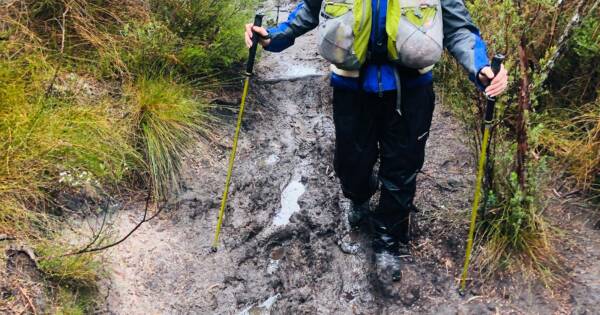Useful knots for hikers in Australia
From securing your belongings to navigating challenging terrain, knots can play a pivotal role in your hiking adventures. Knowing how to tie a few basic knots is an essential part of your hiking skill set. Being able to tie the right knot for the right task can make your hike safer and more enjoyable. Here’s a few knots I’ve found useful on my outdoor adventures.
Reef Knot

The reef knot is also known as the square knot, sailor’s knot, and granny knot. It is a simple and versatile knot that can be used for a variety of purposes, including tying two ropes together, securing a rope to an object, and creating a loop in a rope. The reef knot is a strong and secure knot that is easy to tie and untie. It is also relatively stable under tension, which makes it a good choice for use in situations where the knot may be subjected to a lot of strain.
How to tie a Reef Knot
- Lay the two ropes side by side with the ends of the ropes aligned.
- Make a loop with one of the ropes (we’ll call this rope “rope A”).
- Pass the end of the other rope (rope B) through the loop you just made with rope A.
- Bend rope B around and up through the loop it just created.
- Pull on both ropes to tighten the knot.
Clove Hitch

The clove hitch, also known as the timber hitch or woodman’s hitch, is a simple and versatile knot that is commonly used for securing a rope to a post, tree, or other object. It is a quick and easy knot to tie, and it is also relatively strong and secure. The clove hitch is particularly useful for attaching a rope to a round object, as it will not slip or loosen easily.
How to tie a Clove Hitch
- Pass the working end of the rope around the object you want to secure it to.
- Wrap the working end around the standing end of the rope twice.
- Pull on the working end of the rope to tighten the knot.
Figure-Eight Knot

The figure-eight knot, also known as the figure-of-eight knot or Flemish knot, is a strong and versatile knot that is used for a variety of purposes, including securing a rope to a harness, creating a loop in a rope, and stopping a rope from running through a hole. The knot is also known as the figure-of-eight descent knot when it is used to descend a rope.
How to tie a Figure-Eight Knot
- Make a loop in the rope, leaving about 6 inches (15 cm) of tail.
- Bring the working end of the rope through the loop and down the other side.
- Pass the working end of the rope around the standing end of the rope and up through the loop.
- Pull on both ends of the rope to tighten the knot.
Two Half Hitches

Two half hitches, also known as a double half hitch or clove hitch around itself, is a simple and effective knot for securing a rope to an object. It is a quick and easy knot to tie, even when the rope is wet or dirty. Two half hitches are also relatively strong and secure, making them a good choice for a variety of tasks.
How to tie Two Half Hitches
- Pass the working end of the rope around the object you want to secure it to.
- Wrap the working end around the standing part of the rope twice.
- Pull on the working end of the rope to tighten the knot.
Taut Line Hitch

The taut line hitch, also known as the tarp hitch, is a versatile and adjustable knot commonly used for guying out tarps, tents, and other structures. Its unique design allows for tension adjustments without compromising the knot’s security, making it an essential tool for outdoor enthusiasts and professionals alike. The taut line hitch consists of two interlocking loops that form a 2:1 mechanical advantage system. As tension is applied, the loops tighten against each other, preventing slippage and maintaining the desired tension in the rope or cord. The knot’s design allows for easy adjustment by simply pulling on the working end of the rope, causing the loops to slide relative to each other.
How to tie the Taut Line Hitch
- Create a Loop: Attach the rope or cord to the object you want to secure, such as a tarp or tent tie-out point. Make a loop with the working end of the rope, leaving about 6-12 inches of tail.
- Initial Wrap: Pass the working end of the rope around the object and then through the loop you just created.
- Second Wrap: Bring the working end of the rope around the object again, this time wrapping it around the standing end of the rope once.
- Loop Formation: Pass the working end of the rope through the loop created in step 2, forming a second loop.
- Tension Adjustment: Pull on both the working end and standing end of the rope to tighten the knot.
Sheet Bend

The sheet bend, also known as the weaver’s knot or double sheet bend, is a versatile and secure knot used for joining two ropes of different diameters together. Its simple structure and strong grip make it a popular choice among hikers, climbers, sailors, and anyone who works with ropes or cords. The sheet bend consists of a series of wraps around both ropes, creating a secure connection that can withstand varying load conditions. The knot’s design allows for easy tying and untieing, even when the ropes are wet or dirty.
How to tie the Sheet Bend
- Form a Loop: Make a loop with the thicker rope, leaving about 6-12 inches of tail.
- Initial Wrap: Pass the working end of the thinner rope through the loop of the thicker rope.
- Double Wrap: Wrap the working end of the thinner rope around the thicker rope twice, going around both the standing end and the loop.
- Secure the Knot: Pass the working end of the thinner rope back through the loop created in step 2.
- Tighten the Knot: Pull on both the working end of the thinner rope and the standing end of the thicker rope to tighten the knot.
Bowline Knot

The bowline knot, also known as the King of Knots, is a versatile and indispensable knot that forms a fixed loop in the end of a rope. Its strength, security, and ease of tying make it a valuable tool for various applications, ranging from lowering packs, hanging food, to lowering companions in emergency situations. The bowline knot consists of a series of wraps and loops that interlock to create a secure and stable loop. The knot’s design allows for the loop to remain fixed under tension while also enabling easy untieing when the tension is released.
How to tie a Bowline Knot
- Create a Bight: Make a loop in the rope, leaving about 6-12 inches of tail. This loop is called the “bight.”
- Form the Eye: Pass the working end of the rope through the bight from underneath. This forms the “eye” of the bowline.
- Wrap Around the Standing End: Bring the working end of the rope around the standing end of the rope once.
- Pass Through the Eye: Pass the working end of the rope back through the eye, going from top to bottom.
- Tighten the Knot: Pull on both the working end and standing end of the rope to tighten the knot.
Fisherman’s Bend Knot

The Fisherman’s Bend Knot, also known as the Double Fisherman’s Knot or Anchor Knot, is a strong and secure knot used for joining two ropes of the same diameter together. Its simple structure and reliable hold make it a popular choice for various applications, including hiking, fishing, boating, and construction work. The Fisherman’s Bend Knot consists of two interlocked loops that form a secure connection between the two ropes. The knot’s design allows for even distribution of tension across the ropes, preventing slippage and maintaining a strong hold even under varying load conditions.
How to tie the Fisherman’s Bend Knot
- Overlap the Ropes: Lay the two ropes of equal diameter parallel to each other with about 6-12 inches of overlap.
- Initial Wrap: Take the working end of one rope (Rope A) and make two full wraps around both ropes, going over the top of Rope B and under the bottom of Rope B.
- Secure the Knot: Pass the working end of Rope A through the loop created by Rope B. This loop is formed by the overlapping ends of the two ropes.
- Repeat the Process: Repeat the process with the working end of Rope B, making two full wraps around both ropes and passing it through the loop created by Rope A.
- Tighten the Knot: Pull on both the working end of Rope A and the working end of Rope B to tighten the knot.
Prusik Knot

The Prusik knot, also known as the Prussian knot or friction hitch, is a versatile and indispensable knot used in rope climbing, canyoneering, mountaineering, caving, rope rescue, ziplining, and arboriculture. Its primary function is to ascend or descend a rope by utilising friction to create a secure grip on the rope. The Prusik knot consists of a series of wraps around the rope, forming loops that interlock and create friction against the rope’s surface. The knot’s design allows for easy adjustment and movement along the rope while maintaining a secure grip under tension.
How to tie the Prusik knot
- Create a Loop: Make a loop in the Prusik cord, leaving about 6-12 inches of tail. This loop will be the attachment point to the harness or carabiner.
- Initial Wrap: Pass the working end of the Prusik cord around the main rope four to six times, going over the top of the main rope and under the bottom each time.
- Insert the Loop: Pass the loop end of the Prusik cord through the loops created by the wraps.
- Tighten the Knot: Pull on both the working end and loop end of the Prusik cord to tighten the knot around the main rope.
Alpine Butterfly Knot

The Alpine Butterfly Knot, also known as the Swiss Loop, Butterfly Loop, and Lineman’s Rider, is a strong, secure, and versatile loop knot commonly used for various applications, including securing a rope to a harness, creating a loop in a rope for rappelling or belaying, and attaching a rope to a carabiner or other hardware. Its simple structure, ease of tying, and reliable hold make it a popular choice among climbers, hikers, arborists, and anyone who works with ropes. The Alpine Butterfly Knot consists of a series of wraps and loops that interlock to form a secure and stable loop. The knot’s design allows for easy tying and untieing, even when the rope is wet or dirty. It also maintains its strength and integrity under various load conditions.
How to tie the Alpine Butterfly Knot
- Create a Loop: Make a loop in the rope, leaving about 6-12 inches of tail. This loop will form the basis of the knot.
- Initial Wrap: Pass the working end of the rope around the standing end of the rope twice, going over the top of the standing end and under the bottom each time.
- Second Wrap: Bring the working end of the rope up through the loop created in step 1, passing over the loop’s base.
- Final Wrap: Pass the working end of the rope around the standing end of the rope once more, going over the top of the standing end and under the bottom.
- Tighten the Knot: Pull on both the working end and standing end of the rope to tighten the knot.
Tips for tying knots
- Practice tying knots regularly so that you can tie them quickly and easily when you need to.
- Use a rope that is the right size for the knot you are tying.
- Make sure that the ends of the rope are smooth and free of burrs.
- Tie the knot tightly and evenly.
- Check the knot before you use it to make sure that it is secure.
Additional knots
In addition to the knots listed above, there are a few other knots that you may find useful for hiking. These include:
- Square lashing: Used for lashing two poles together to create a stretcher or shelter.
- Guyline hitch: Used for securing a guyline to a tent or tarp peg.
- Tripod lashing: Used for lashing three poles together to create a tripod.
I hope this post has been helpful. Please let me know if you have any questions or if you know of any other commons knots that should be included.






What’s your go-to knot? I seem to use the clive hitch more than anything else.
it’s the ” you take care of it” knot!
Jim Roberts hahaha. Love it
Great post Darren. Thanks.